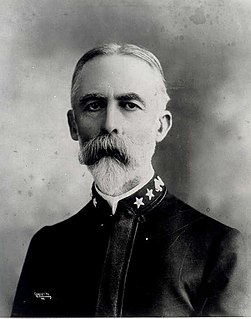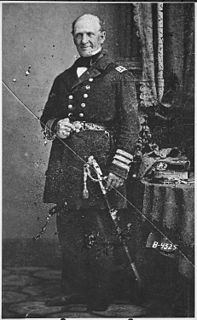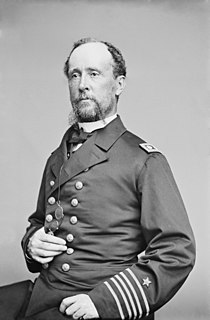
Egersund is a town in Eigersund municipality in Rogaland county, Norway. The town is located along the southwestern coast of Norway, about 75 kilometres (47 mi) south of the city of Stavanger. The town is situated along a strait which separates the mainland from the island of Eigerøya. The 6.36-square-kilometre (1,570-acre) village has a population (2015) of 11,473 which gives the town a population density of 1,804 inhabitants per square kilometre (4,670/sq mi).

William Thomas Sampson was a United States Navy rear admiral known for his victory in the Battle of Santiago de Cuba during the Spanish–American War.

John Rodgers was an admiral in the United States Navy. He began his naval career as a commander in the American Civil War and during his Postbellum service became an admiral.

Rear Admiral Silas Horton Stringham was an officer of the United States Navy who saw active service during the War of 1812, the Second Barbary War, and the Mexican–American War, and who commanded the Atlantic Blockading Squadron at the beginning of the American Civil War.

William Rogers Taylor was a rear admiral of the United States Navy who served during the Mexican–American War and the American Civil War.

Rear Admiral Christopher Raymond Perry Rodgers was an officer in the United States Navy. He served in the Mexican–American War, the American Civil War, as Superintendent of the Naval Academy, President of the United States Naval Institute, and Commander-in-Chief of the Pacific Squadron.

Daniel Lawrence Braine was an admiral of the United States Navy in the 19th century.

Cameron McRae Winslow served in the United States Navy during the Spanish–American War and World War I. A son of Commander Francis Winslow (I) (1818–1862),

James Henry Gillis was a rear admiral in the United States Navy. His active-duty career extended from the 1850s through the 1890s, including service in the American Civil War.
Samuel Livingston Breese was a Rear Admiral in the United States Navy. His active-duty career included service in the War of 1812, the Mexican–American War, and the American Civil War.

Admiral Jonas Howard Ingram was an officer in the United States Navy during World War I and World War II. He commanded the United States Atlantic Fleet during World War II and was a recipient of the Medal of Honor for his actions in 1914 in Veracruz, Mexico.
Hispanic Admirals in the United States Navy can trace their tradition of naval military service to the Hispanic sailors, who have served in the Navy in every war and conflict since the American Revolution. Prior to the Civil War, the highest rank reached by a Hispanic-American in the Navy was commodore. Such was the case of Commodore Uriah Phillips Levy (1792–1862), a Sephardic Jew of Hispanic descent and great grandson of Dr. Samuel Nunez, who served in the War of 1812. During the American Civil War, the government of the United States recognized that the rapid expanding Navy was in need of admirals therefore, Congress proceeded to authorize the appointment of nine officers the rank of rear admiral. On July 16, 1862, Flag Officer David Glasgow Farragut became the first Hispanic-American to be appointed to the rank of rear admiral. Two years later (1864), Farragut became a vice admiral, and in 1866 the Navy's first full admiral. During World War I, Robert Lopez, the first Hispanic graduate of the United States Naval Academy, served with the rank of commodore in command of the Mare Island Naval Shipyard, and during World War II five Hispanics served with the ranks of rear admiral or above in either the European or Pacific Theater's of the war. As of April 2007, twenty-two Hispanic-Americans have reached the rank of admiral, and of this number thirteen were graduates of the USNA.
Hispanics in the United States Naval Academy account for the largest minority group in the institution. According to the Academy, the Class of 2009 includes 271 (22.2%) minority midshipmen. Out of these 271 midshipmen, 115 are of Hispanic heritage. In 2004, of the total of 736 female midshipmen, 74 (10%) of them were of Hispanic descent.

Hugo Osterhaus was a Rear Admiral in the United States Navy. He was the son of Civil War Major General Peter J. Osterhaus (1823–1917) and father of Navy Admiral Hugo Wilson Osterhaus (1878–1972), and is buried on Arlington National Cemetery.

Admiral Louis Rodolph de Steiguer was an officer in the U.S. Navy. He was Commander-in-Chief of the U.S. Battle Fleet from 1927 to 1928.

Charles Philip Snyder was a four-star admiral in the United States Navy who served as the U.S. Navy's first Naval Inspector General during World War II.
Joshua Ratoon Sands was an officer in the United States Navy who rose to the rank of Rear Admiral. He served in the War of 1812, the Mexican–American War, and the Civil War.

Rear Admiral William Mayhew Folger was an officer in the United States Navy. He served in the American Civil War without seeing action. He filled a wide range of roles, including Chief of the Bureau of Ordnance, over the following 30 years. He fought in the Spanish–American War as captain of the protected cruiser USS New Orleans. Folger served as a lighthouse inspector before becoming commander of the Philippine Squadron during the Philippine–American War, and was briefly Commander-in-Chief of the United States Asiatic Fleet. He retired in 1905 as a rear admiral.
Rear Admiral Warner Baldwin Bayley was a United States Navy officer. His career specialized in engineering and included service in the Spanish–American War and the investigation of the sinking of the battleship USS Maine.


















